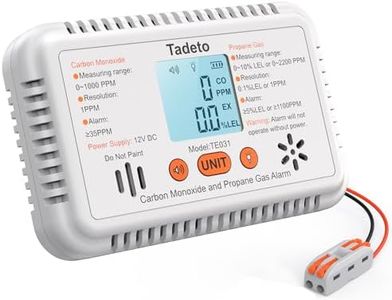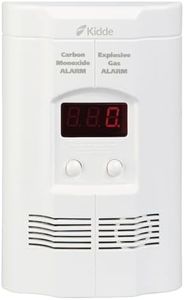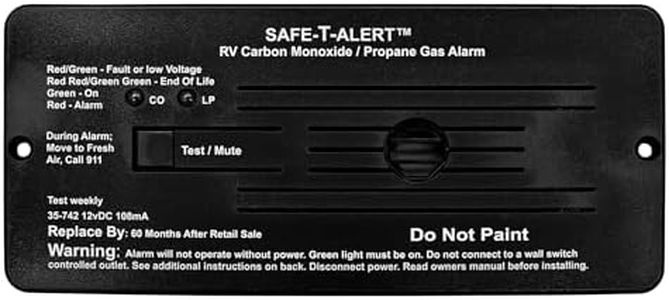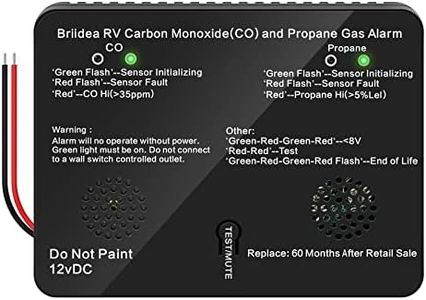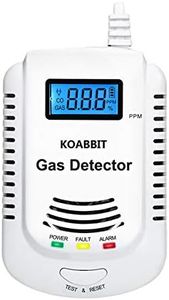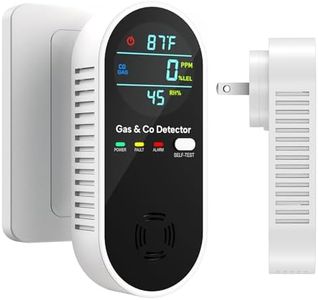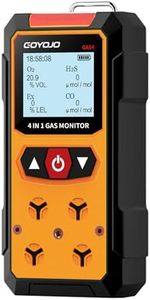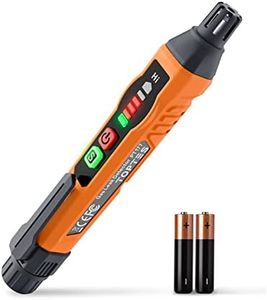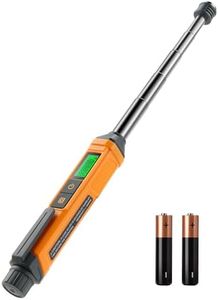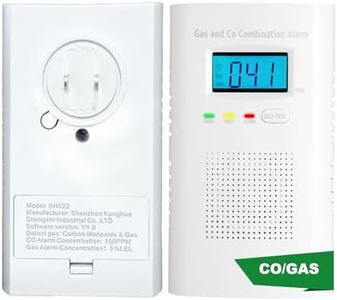7 Best Carbon Monoxide And Natural Gas Detector 2025 in the United States
Our technology thoroughly searches through the online shopping world, reviewing hundreds of sites. We then process and analyze this information, updating in real-time to bring you the latest top-rated products. This way, you always get the best and most current options available.

Our Top Picks
Winner
Kidde Carbon Monoxide Detector, Propane, Natural, Methane, & Explosive Gas Alarm, Plug-In Wall with 9-Volt Battery Backup, Digital LED Display
Most important from
16760 reviews
The Kidde Carbon Monoxide Detector is designed to keep your home safe from dangerous gases like carbon monoxide and explosive gases. Its plug-in design makes installation straightforward—simply find a standard outlet, and you’re good to go. One notable strength is the 9-volt battery backup, which ensures that the detector continues working even during power outages, providing you with peace of mind.
This detector features a digital LED display that clearly shows the level of carbon monoxide detected, or alerts you if explosive gas is present. The loud 85-decibel alarm is essential for alerting you promptly to any danger. The Peak Level Memory feature is another plus, allowing you to check the last time carbon monoxide was detected, which can be useful for monitoring safety in your home.
There are a few drawbacks to consider. While the unit is UL Listed and has a reasonable lifespan of 7 years, the warranty is limited to just 5 years from activation, which may not provide long-term reassurance. Additionally, while the design allows for versatility in placement thanks to the included extension cord, its reliance on being plugged in might limit where you can position it, especially in spaces without convenient outlets. The Kidde CO detector's sensitivity and detection range are adequate for residential use, operating effectively within a broad humidity range, but it may not be suitable for larger commercial spaces that require more extensive coverage. This product is ideal for homeowners seeking an easy-to-install, reliable solution for detecting carbon monoxide and gas leaks.
Most important from
16760 reviews
Safe T Alert - Dual LP/CO Alarm - Flush Mount Black - 35-742-BL
Most important from
2243 reviews
The Safe-T-Alert by MTI Industries 35-742-BL is a solid choice for anyone in need of a reliable carbon monoxide and natural gas detector. Its dual functionality allows it to simultaneously detect both gas leaks and carbon monoxide, making it highly efficient for safety in various settings, particularly in RVs and other mobile homes. One of its standout features is the battery-powered design, which eliminates the hassle of changing batteries frequently. With a reliable 12V power source, users can trust that the alarm will work when needed most, even in extreme temperatures ranging from -40°F to +158°F.
The flush mount style is aesthetically pleasing and does not take up much space, making it suitable for compact areas. Additionally, it meets important safety standards, being certified by RVIA/NFPA and listed to UL 1484 RV and UL 2034 RV, which adds to its credibility.
On the flip side, while the plastic material is lightweight, it may not be as durable as metal options, especially in environments where it might be subjected to wear and tear. The alarm being solely audible means there is no visual alert, which could be a drawback for those who might not hear the alarm in a noisy environment. Lastly, while battery-powered is convenient, it could lead to a potential oversight if users forget to check on the alarm’s operability over time.
Most important from
2243 reviews
Tadeto RV Carbon Monoxide and Propane Gas Alarm, 12V DC Hardwired CO/LPG Gas Leak Alarm with Light and Audible Indicator, RV Propane Detector with Reset/Backlight for RV/Trailer/Camper
Most important from
409 reviews
The Tadeto RV Carbon Monoxide and Propane Gas Alarm is a versatile 2-in-1 device designed specifically for RVs, trailers, and campers. It is equipped with electrochemical sensors that independently detect carbon monoxide and propane gas, offering reliable and high-sensitivity detection. The device runs on a 12V DC power supply, making it ideal for mobile environments. Its audible alarm emits an 85-decibel sound when dangerous levels of gas are detected, coupled with a flashing red light for visual alerts, ensuring users are promptly informed of potential hazards.
The large display with backlight function allows for easy reading of gas levels, even in low-light conditions, and the mute button offers additional convenience for users. Installation is straightforward with included accessories, and users can choose between nut-based or Velcro mounting methods. One notable strength of this product is its dual-gas detection capability, which can save space and cost compared to purchasing separate detectors.
A potential drawback may be its reliance on a corded electric power source, which could limit placement flexibility within the RV. Additionally, users should ensure the 12V power supply is compatible with their specific RV setup. The Tadeto RV Carbon Monoxide and Propane Gas Alarm is an excellent choice for those seeking comprehensive gas detection in their RV, providing both safety and ease of use.
Most important from
409 reviews
Buying Guide for the Best Carbon Monoxide And Natural Gas Detector
Choosing the right carbon monoxide and natural gas detector is crucial for ensuring the safety of your home or workplace. These detectors can alert you to dangerous levels of carbon monoxide and natural gas, which are both colorless and odorless, making them difficult to detect without the proper equipment. When selecting a detector, it's important to consider several key specifications to ensure you get a device that meets your needs and provides reliable protection.FAQ
Most Popular Categories Right Now
